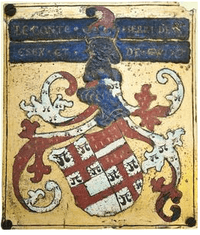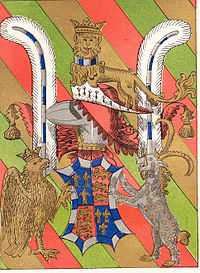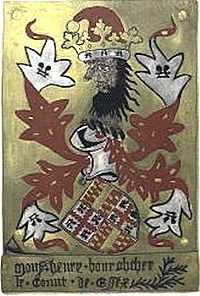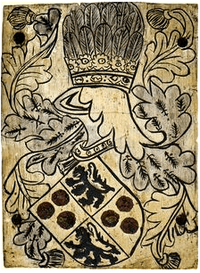Garter stall plate
From Wikipedia, the free encyclopedia

Garter stall plate of Henry Bourchier, 2nd Earl of Essex (d.1540), nominated 1499, showing his name, titles and heraldic achievement

Stalls of Knights of the Garter, St George's Chapel, Windsor Castle. The Garter stall plates are visible affixed to the rear panelling of each stall
Garter stall plates are small enamelled and engraved brass stall plates located in St George's Chapel, Windsor Castle, as memorials to Knights of the Garter. They are inscribed with the knight's name, and generally with his titles, offices, and motto. In most cases his heraldic achievement is depicted. Each knight was allotted a stall in St George's Chapel and the stall plate was affixed to his personal stall. His successor knight in that stall added his own stall plate and thus a fairly complete series of stall plates survives for the successive occupants of each stall. Many other ancient European Orders of Chivalry use similar stall plates in the home church or other building of their order.
Significance
Stall plates are important for several reasons:
- They are works of art in their own right which demonstrate the skills of medieval and later metal workers and enamellers.
- They are an extremely valuable source to students of heraldry as they show contemporary images of ancient arms the provenance and reliability of which is second to none. Unlike ancient seals which often survive, they show not only the form of the arms but generally also the tinctures (colours).
- They contain inscriptions which were used as evidence during legal disputes concerning devolution of peerage titles. However, as was demonstrated by J. Horace Round (d.1924),[1] the stall plates from about the mid-16th century frequently were inscribed with titles which were not legally held by the knight, but were merely ornate styles, frequently baronies which had never existed or were not theirs by right. The question addressed by Round was whether such styles inscribed on a Garter stall plate could form legal evidence in a court of law to prove that the knight had legally held the title recited on his stall plate. Before the 21st century and the curtailment of a peer's right to a seat in parliament, such issues were clearly of great importance. An example of such a case was that of 1912 concerning the Barony of Furnivall. The apellant proposed in support of her claim that the stall plate of Henry Howard, 7th Duke of Norfolk (1655-1701), KG, nominated to the Order in 1685, was inscribed with the style of "Lord Furnivall". She herself was descended from the Duke. Similarly in 1692 Henry Howard, 5th Earl of Suffolk (1627-1709) had made a claim to the Barony of Howard de Walden based on the evidence from three Garter stall plates which purported to show that baronies by writ did not pass away with heirs general but were retained by the heir male, if he were an earl, with his earldom. This is known as the "Doctrine of Attraction", namely that an earldom attracts a barony.
Regulation
King Henry VIII (1509-1547) made a statute of the Order of the Garter relating to stall plates as follows:[2]"It is agreed that every knyght within the yere of his stallation shall cause to be made a scauchon of his armes and hachementis in a plate of metall suche as shall please him and that it shall be surely sett upon the back of his stall. And the other that shall come after shall have their scochons and hachements in like manner; but their plates of metall nor their hachements shall not be soo large nor soo greatte as they of the first Founders were excepte strangers which may use their plates and fashions at their pleasure"
List of surviving Garter stall plates
- This list is incomplete; you can help by expanding it.
| Image | Name | Year nominated | Arms & blazon |
|---|---|---|---|
 |
John Beaufort, 1st Duke of Somerset (1403-1444) | 1443 | |
 |
Henry Bourchier, 1st Earl of Essex (c.1404/6-1483) | 1452 |  Argent, a cross engrailed gules between four water bougets sable (Bourchier) |
 |
Edward Courtenay, 1st Earl of Devon (d.1509) | 1494 | |
 |
Henry Bourchier, 2nd Earl of Essex (d.1540) | 1499 |  Argent, a cross engrailed gules between four water bougets sable (Bourchier) |
Sources
- Royal Collection, Special Feature: The Knights of the Garter Under Henry VIII
- Round, J. Horace, Family Origins and Other Studies, Page, William, (ed.), London, 1930, pp.174-189, The Garter Plates and Peerage Styles
Further reading
- Hope, Sir W.H. St John, The Stall Plates of the Knights of the Order of the Garter (1348-1485), 1901. (A work concerning mainly heraldry)
- The Knights of the Garter, 1348–1939: With a Complete List of the Stall Plates in St. Georges Chapel. Historical monographs relating to St. George's Chapel, Windsor Castle Volume 1. Edmund Fellowes (SPCK – 1939)
External links
| Wikimedia Commons has media related to Stall plates of Knights of the Garter. |
References
This article is issued from Wikipedia. The text is available under the Creative Commons Attribution/Share Alike; additional terms may apply for the media files.

